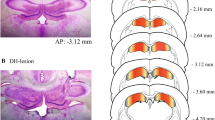Summary
Recordings were made of spontaneous hippocampal theta activity in free-moving rats, before and after a variety of lesions. Three recording sites were used to monitor activity in the dorsal hippocampus, the ventral hippocampus, or close to the site of the hippocampal flexure. Electrolytic lesions were made in the medial septal area or the dorso-lateral septal area; surgical transections were made of the fimbria or dorso-medial area of the fornix. Following lesions restricted to the medial septal area, theta was abolished throughout the hippocampus; after lesions restricted to the dorso-lateral septal area theta was retained. Fimbria lesions abolished theta in the ventral, but not the dorsal hippocampus; dorso-medial fornix lesions abolished it in the dorsal, but not the ventral, hippocampus. In some subjects the hippocampal formation was subsequently stained for cholinesterase: cholinesterase staining loss was generally associated with theta loss, but this was not clear at the flexure recording site. It was confirmed that theta is dependent upon the integrity of the medial septal area. It was concluded that damage to hippocampal afferents from the septum does abolish theta, while damaging the feedback efferents does not.
Similar content being viewed by others
References
Apostol, G., Creutzfeldt, O.D.: Cross correlation between the activity of septal units and hippocampal EEG during arousal. Brain Res.67, 65–75 (1974)
Bland, B.H., Andersen, P., Ganes, T.: Two generators of hippocampal theta activity in rabbits. Brain Res.94, 199–218 (1975)
Dudar, J.D.: The effect of septal nuclei stimulation on the release of acetylcholine from the rabbit hippocampus. Brain Res.83, 123–133 (1975)
Feldon, J., Rawlins, J.N.P: tThe anatomical basis of hippocampal theta rhythm. J. Physiol. (Lond.)284, 81P (1978)
Gray, J.A., Ball, G.G.: Frequency-specific relation between hippocampal theta rhythm, behaviour, and amobarbital action. Science168, 1246–1248 (1970)
Gray, J.A., Feldon, J., Rawlins, J.N.P., Owen, S., McNaughton, N.: The role of the septohippocampal system and its noradrenergic afferents in behavioural responses to non-reward. In: Whelan, J. (Ed.). Functions of the septo-hippocampal system. Ciba Foundation Symposium No. 58 (New Series), pp. 275–300. Amsterdam: Elsevier 1978
James, D.T.D., McNaughton, N., Rawlins, J.N.P., Feldon, J., Gray, J.A.: Septal driving of hippocampal theta rhythm as a function of frequency in the free-moving male rat. Neuroscience2, 1007–1017 (1977)
Jarrard, L.E.: Anatomical and behavioural analysis of hippocampal cell fields in rats. J. Comp. Physiol. Psychol.90, 1035–1050 (1976)
Koelle, G.B.: The histochemical localization of cholinesterases in the central nervous system of the rat. J. Comp. Neurol.100, 211–228 (1954)
König, J.F. R., Klippel, R.A.: The rat brain. Baltimore: Williams and Wilkins 1963
Lewis, P.R., Shute, C.C.D.: The cholinergic limbic system: Projections to hippocampal formation, medial cortex, nuclei of the ascending cholinergic reticular formation, and the subfornical organ and supraoptic crest. Brain90, 521–540 (1967)
Mellgren, S.I., Srebro, B.: Changes in acetylcholinesterase and distribution of degenerating fibres in the hippocampal region after septal lesions in the rat. Brain Res.52, 19–36 (1973)
McLennan, H., Miller, J.J.: The hippocampal control of neuronal discharges in the septum of the rat. J. Physiol (Lond.)237, 607–624 (1974)
McLennan, H., Miller, J.J.: Frequency-related inhibitory mechanisms controlling rhythmical activity in the septal area. J. Physiol. (Lond.)254, 827–841 (1976)
Meibach, R.C., Siegal, A.: Efferent connections of the septal area in the rat: an analysis utilizing retrograde and anterograde transport methods. Brain Res.119, 1–20 (1977)
Myhrer, T.: Locomotor, avoidance, and maze behaviour in rats with selective disruption of hippocampal output. J. Comp. Physiol. Psychol.89, 759–777 (1975a)
Myhrer, T.: Normal jump avoidance performance in rats with the hippocampal theta rhythm selectively disrupted. Behav. Biol.14, 489–498 (1975b)
Petsche, H., Stumpf, Ch., Gogolak, G.: The significance of the rabbit's septum as a relay station between the midbrain and the hippocampus. I. The control of hippocampus arousal activity by the septum cells. Electroenceph. Clin. Neurophysiol.14, 202–211 (1962)
Raisman, G.: The connexions of the septum. Brain89, 317–348 (1966)
Stumpf, C.: Drug action on the electrical activity of the hippocampus. Int. Rev. Neurobiol.8, 77–138 (1965)
Vanderwolf, C.H.: Limbic diencephalic mechanisms of voluntary movement. Psychol. Rev.78, 83–113 (1971)
Vanderwolf, C.H., Kramis, R., Gillespie, L.A., Bland, B.H.: Hippocampal rhythmic slow activity and neocortical low-voltage fast activity: relations to behavior. In: Isaacson, R.L. and Pribram, K.H. (Eds.), The hippocampus. Vol. 2, pp. 101–128. New York: Plenum Press
Winson, J.: Patterns of hippocampal theta rhythm in the freely moving rat. Electroenceph. Clin. Neurophysiol.36, 291–301 (1974)
Author information
Authors and Affiliations
Rights and permissions
About this article
Cite this article
Rawlins, J.N.P., Feldon, J. & Gray, J.A. Septo-hippocampal connections and the hippocampal theta rhythm. Exp Brain Res 37, 49–63 (1979). https://doi.org/10.1007/BF01474253
Received:
Issue Date:
DOI: https://doi.org/10.1007/BF01474253




